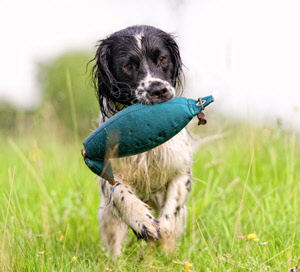Gun Dog Training Basics

Your hunting dog is an incredibly valuable asset when you are in the field. If the animal isn’t trained correctly, however, the asset can turn into a liability quickly. Improperly trained dogs are dangers to themselves and others, and will likely ruin your chances of a successful hunt. Developing a good hunting dog should start early on, and should focus on the following:
- Familiarization and Socialization – it is important to acclimate your potential hunting dog with the sensation of being around unfamiliar people, places, and things. In the field, a dog will encounter any number of scenarios and it should be able to respond predictably and uniformly to each. Presenting them with different scenarios and getting them to relax early on is difficult, but essential.
- Undivided Attention – getting your animal’s attention when required is the first step to real training. The dog needs to respond to its name, first and foremost, and should look directly at you when the name is called. This type of focus is paramount for any dog training, and is the basis for hunting dog obedience.
Essential Hunting Dog Commands
Once you have instilled the basic behavioral traits listed above, real hunting dog training can begin. Using basic positive reinforcement training methods, and an array of bird dog training tools, you can begin teaching command obedience. This is a process, and should be taken slowly, with managed expectations. Some basic commands should be taught to your hunting dog partner:
- Here/Come – whichever word you use, the intent is the same: getting your animal to return to your side.
- Stay – this is essential for hunting dog training and can be thought of as a safety issue. Your dog needs to sit at your side and behind the range of fire until the desired moment.
- Sit – this is basically an intro to canine behavioral obedience commands.
- No – your dog needs to be able to stop unwanted behavior as soon as it’s told.
- Heel – when your dog is on a leash, it should match its pace with yours. Pulling ahead is particularly undesirable on the hunt, as it could spook potential targets before you’re ready.
- Kennel – your dog needs to not only be comfortable with its transport kennel, but should also enter it upon command.
- Fetch/Retrieve – a must for bird hunting dogs. You’ll want your dog to track down and bring back your hunting quarry, but you’ll need to keep your animal from doing it without your command.
Mastering these basics of bird dog training is required before you even consider bringing your dog out into the field with you. You can get started with Northland Dog Supply’s dog training products.

